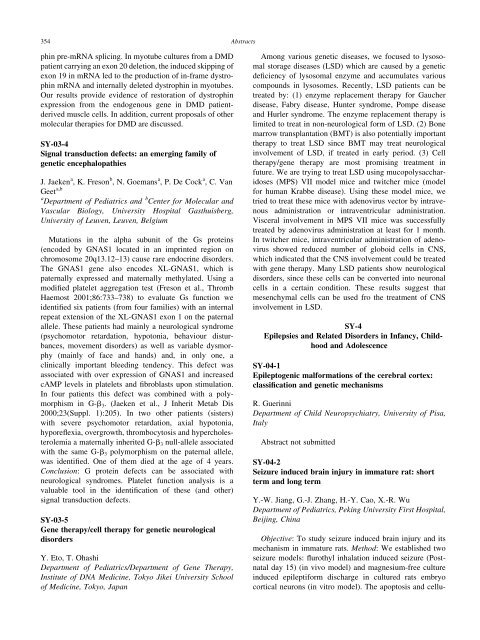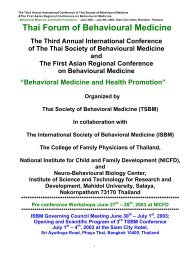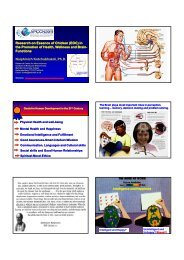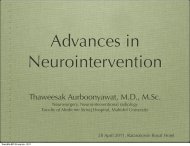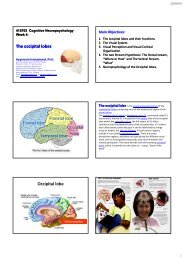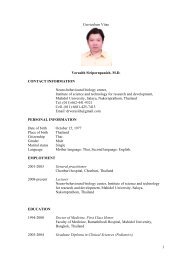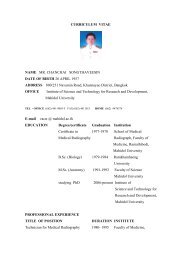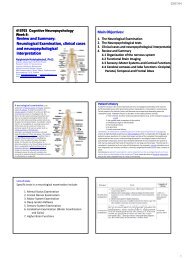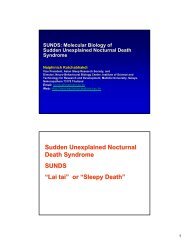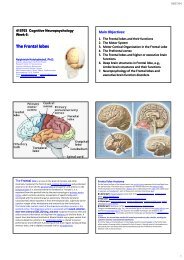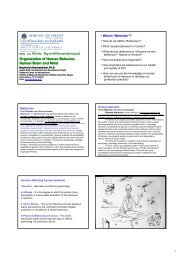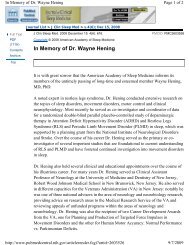PDF File - Mahidol University
PDF File - Mahidol University
PDF File - Mahidol University
You also want an ePaper? Increase the reach of your titles
YUMPU automatically turns print PDFs into web optimized ePapers that Google loves.
354<br />
Abstracts<br />
phin pre-mRNA splicing. In myotube cultures from a DMD<br />
patient carrying an exon 20 deletion, the induced skipping of<br />
exon 19 in mRNA led to the production of in-frame dystrophin<br />
mRNA and internally deleted dystrophin in myotubes.<br />
Our results provide evidence of restoration of dystrophin<br />
expression from the endogenous gene in DMD patientderived<br />
muscle cells. In addition, current proposals of other<br />
molecular therapies for DMD are discussed.<br />
SY-03-4<br />
Signal transduction defects: an emerging family of<br />
genetic encephalopathies<br />
J. Jaeken a , K. Freson b , N. Goemans a , P. De Cock a , C. Van<br />
Geet a,b<br />
a Department of Pediatrics and b Center for Molecular and<br />
Vascular Biology, <strong>University</strong> Hospital Gasthuisberg,<br />
<strong>University</strong> of Leuven, Leuven, Belgium<br />
Mutations in the alpha subunit of the Gs proteins<br />
(encoded by GNAS1 located in an imprinted region on<br />
chromosome 20q13.12–13) cause rare endocrine disorders.<br />
The GNAS1 gene also encodes XL-GNAS1, which is<br />
paternally expressed and maternally methylated. Using a<br />
modified platelet aggregation test (Freson et al., Thromb<br />
Haemost 2001;86:733–738) to evaluate Gs function we<br />
identified six patients (from four families) with an internal<br />
repeat extension of the XL-GNAS1 exon 1 on the paternal<br />
allele. These patients had mainly a neurological syndrome<br />
(psychomotor retardation, hypotonia, behaviour disturbances,<br />
movement disorders) as well as variable dysmorphy<br />
(mainly of face and hands) and, in only one, a<br />
clinically important bleeding tendency. This defect was<br />
associated with over expression of GNAS1 and increased<br />
cAMP levels in platelets and fibroblasts upon stimulation.<br />
In four patients this defect was combined with a polymorphism<br />
in G-b 3 . (Jaeken et al., J Inherit Metab Dis<br />
2000;23(Suppl. 1):205). In two other patients (sisters)<br />
with severe psychomotor retardation, axial hypotonia,<br />
hyporeflexia, overgrowth, thrombocytosis and hypercholesterolemia<br />
a maternally inherited G-b 3 null-allele associated<br />
with the same G-b 3 polymorphism on the paternal allele,<br />
was identified. One of them died at the age of 4 years.<br />
Conclusion: G protein defects can be associated with<br />
neurological syndromes. Platelet function analysis is a<br />
valuable tool in the identification of these (and other)<br />
signal transduction defects.<br />
SY-03-5<br />
Gene therapy/cell therapy for genetic neurological<br />
disorders<br />
Y. Eto, T. Ohashi<br />
Department of Pediatrics/Department of Gene Therapy,<br />
Institute of DNA Medicine, Tokyo Jikei <strong>University</strong> School<br />
of Medicine, Tokyo, Japan<br />
Among various genetic diseases, we focused to lysosomal<br />
storage diseases (LSD) which are caused by a genetic<br />
deficiency of lysosomal enzyme and accumulates various<br />
compounds in lysosomes. Recently, LSD patients can be<br />
treated by: (1) enzyme replacement therapy for Gaucher<br />
disease, Fabry disease, Hunter syndrome, Pompe disease<br />
and Hurler syndrome. The enzyme replacement therapy is<br />
limited to treat in non-neurological form of LSD. (2) Bone<br />
marrow transplantation (BMT) is also potentially important<br />
therapy to treat LSD since BMT may treat neurological<br />
involvement of LSD, if treated in early period. (3) Cell<br />
therapy/gene therapy are most promising treatment in<br />
future. We are trying to treat LSD using mucopolysaccharidoses<br />
(MPS) VII model mice and twitcher mice (model<br />
for human Krabbe disease). Using these model mice, we<br />
tried to treat these mice with adenovirus vector by intravenous<br />
administration or intraventricular administration.<br />
Visceral involvement in MPS VII mice was successfully<br />
treated by adenovirus administration at least for 1 month.<br />
In twitcher mice, intraventricular administration of adenovirus<br />
showed reduced number of globoid cells in CNS,<br />
which indicated that the CNS involvement could be treated<br />
with gene therapy. Many LSD patients show neurological<br />
disorders, since these cells can be converted into neuronal<br />
cells in a certain condition. These results suggest that<br />
mesenchymal cells can be used fro the treatment of CNS<br />
involvement in LSD.<br />
SY-4<br />
Epilepsies and Related Disorders in Infancy, Childhood<br />
and Adolescence<br />
SY-04-1<br />
Epileptogenic malformations of the cerebral cortex:<br />
classification and genetic mechanisms<br />
R. Guerinni<br />
Department of Child Neuropsychiatry, <strong>University</strong> of Pisa,<br />
Italy<br />
Abstract not submitted<br />
SY-04-2<br />
Seizure induced brain injury in immature rat: short<br />
term and long term<br />
Y.-W. Jiang, G.-J. Zhang, H.-Y. Cao, X.-R. Wu<br />
Department of Pediatrics, Peking <strong>University</strong> First Hospital,<br />
Beijing, China<br />
Objective: To study seizure induced brain injury and its<br />
mechanism in immature rats. Method: We established two<br />
seizure models: flurothyl inhalation induced seizure (Postnatal<br />
day 15) (in vivo model) and magnesium-free culture<br />
induced epileptiform discharge in cultured rats embryo<br />
cortical neurons (in vitro model). The apoptosis and cellu-


